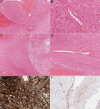Congenital cystic eye with optic nerve
- PMID: 26178229
- PMCID: PMC4513586
- DOI: 10.1136/bcr-2015-210717
Congenital cystic eye with optic nerve
Abstract
Congenital cystic eye (CCE) is a rare condition caused by failure of invagination of the optic vesicle resulting in a persistent cyst replacing the eye. An associated optic nerve attached to the cyst is a rarely reported phenomenon that has been sparsely described histologically, with no immunohistochemistry reported previously. The authors present a case of CCE with optic nerve tissue inserting into the cyst, and present the histological and immunohistochemical findings.
2015 BMJ Publishing Group Ltd.
Figures



References
-
- Mann I. A case of congenital cystic eye. Trans Ophthalmol Soc Aust 1939;1:120–4.
Publication types
MeSH terms
LinkOut - more resources
Full Text Sources
Other Literature Sources
